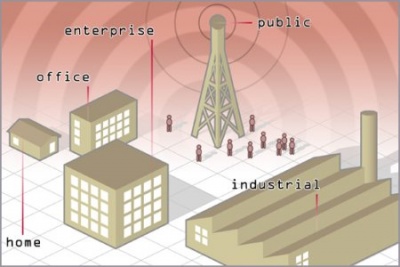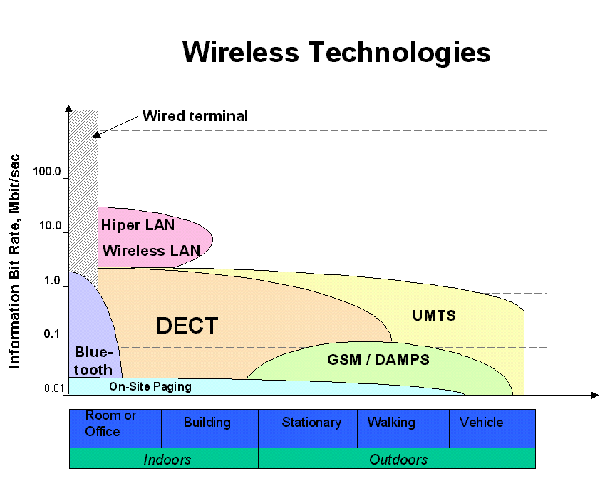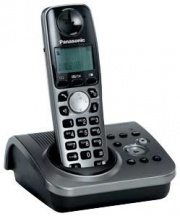Digital Enhanced Cordless Telecommunications (DECT)
From Computing and Software Wiki
DECT or Digital Enhanced Cordless Telecommunications is a radio standard for short-range cordless communications. It is commonly used for domestic or corporate purposes. It is suited to voice, data and networking applications with a range of up to 500 metres.
DECT was developed by the European Telecommunications Standards Institute (ETSI); an independent, non-profit, standardization organization in the telecommunications industry in Europe. Although DECT was developed by ETSI it has since been adopted by many countries all over the world.
While the original DECT frequency band is 1880 MHz - 1900 MHz, the frequency allocation has changed in some countries like the United States so that DECT devices can be sold there. Since these channels are reserved exclusively for voice communication applications, they are much less likely to experience interference from other wireless devices such as wireless networks or baby monitors. DECT devices are therefore known as being interference free.
Contents |
Applications

DECT has numerous applications and services. The range of DECT applications are listed below:
- Residential
- Public Switched Telephone Network (PSTN) access
- Integrated Services Digital Network (ISDN) access
- Wireless Private Branch Exchange (PABX)
- Global System for Mobile communications (GSM) access
- Wireless Local Loop
- Cordless Terminal Mobility (CTM)
- Local Area Network access supporting voice telephony, fax, modem, E-mail, Internet, X.25 and many other services
The DECT standard originally envisaged three major areas of application:1
- domestic cordless telephony, using a single base station to connect one or more handsets to the public telecoms network, which is now available
- enterprise premises cordless PABXs and wireless LANs, using many base stations for coverage. Calls continue as users move between different coverage cells, through a mechanism called handover. Traffic both within the system and to the public telecoms network
- public access, using large numbers of base stations to provide building or urban area coverage as part of a public telecoms network.
The domestic application, or cordless home telephones, has been very successful. The enterprise PABX market has had some success, but the public access application has not succeeded, since public cellular networks have fulfilled the need better.
DECT Features
Common features of the DECT Standard include:2
- Flexible bandwidth
- High subscriber densities
- Interoperability
- Mobility
- High Quality Voice
- Robust self organizing real time radio channel selection
- Cost efficiency
- High level of security
- Coexistence
- Standard interworking profiles
- Multiple access rights
- Seamless handover
- Multi-mode terminals
- Extended battery talk time
Digital Radio Techniques
The DECT standard allows for the proficient use of the radio spectrum through several advanced digital radio techniques. Delivering low risk of radio interference and low power technology, the DECT standard still ensures high speech quality and security. DECT digital radio techniques include: 3
- TDMA (Time Division Multiple Access) radio access – low radio interference and high system capacity; is capable of handling up to 100'000 users per km² floor space in an office.
- ADPCM (Adaptive Differential Pulse Code Modulation) speech encoding – ensures that DECT phones have very high speech quality, which is similar to wireline telephony
- DCS/DCA (Dynamic Channel Selection / Allocation) is a unique DECT capability that guarantees that the best radio channels available are used; For example, this happens when a cordless phone is in standby mode as well as throughout the call; this feature also ensures that DECT telephony can coexist with other DECT applications, and with other systems in the same frequency, with high-quality, robust and secure communications for end-users
- Some other features - Encryption for maximum call security and optimized radio transmission for maximum battery life.
DECT basic technology and the various profiles enhance the DECT standard, introducing evolutionary applications and services. The GAP profile, for example, ensures interoperability of equipment from different providers for voice applications.
Technical Details
Some DECT properties:1
- Audio codec: G.726
- Net bit rate: 32 kbit/s
- Frequency: 1880 MHz–1900 MHz in Europe, 1900 MHz-1920 MHz in China, 1910 MHz-1930 MHz in Latin America and 1920 MHz–1930 MHz in the US
- Carriers: 10 (1,728 kHz spacing) in Europe, 5 (1,728 kHz spacing) in the US
- Time slots: 2 x 12 (up and down stream)
- Channel allocation: dynamic
- Average transmission power: 10 mW (250 mW peak) in Europe, 4 mW (100 mW peak) in the US
The table below shows some of the important layers of the DECT standard:
| Title | Description |
|---|---|
| 1. Overview | General introduction to the other parts of ETS 300 175 |
| 2. Physical Layer | Radio requirements of DECT, e.g. carrier frequency allocation, modulation method, transmission frame structure, transmitted power limits, spurious emission requirements etc. |
| 3. Medium Access Control Layer | Description of procedures, messages, and protocols for radio resource man-cess Control agement i.e. link set-up, channel selection, handover, link release and link layer quality maintenance etc. |
| 4. Data Link | Description of provisions to secure a reliable data link to the network layer Control layer. |
| 5. Network layer | Description of the signalling layer with call control and mobility management functions and protocols. |
| 6. Identities and Adressing | Description of the portable and fixed part identities requirements for all Addressing DECT application environments. |
| 7. Security aspects | Procedures to prevent eavesdropping, unauthorised access and fraudulent use. |
| 8. Telephony | Telephony requirements for systems supporting the 3.1 kHz speech service to ensure proper interworking with public telecommunications networks. De-fines transmission levels, loudness ratings, sidetone levels, frequency re-sponse, echo control requirements etc. |
DECT Technologies
DECT 6.0
DECT devices that are made in the U.S are termed DECT 6.0 to distinguish them from other DECT devices. Some other U.S cordless devices operate in the 900 MHz, 2.4GHz and 5.8GHz bands. DECT 6.0 is not a spectrum band reference but rather a marketing term coined when DECT was accepted in the U.S. The term 6.0 GHz is actually incorrect for DECT 6.0 because it operates at 1.9 GHz. DECT 1.9 may have confused customers because they associate a larger number with a better or later product. 1
DECT Data Networks
There are other possibilities that exist with the DECT standard, particularly the DPRS (DECT Packet Radio Services). It allows DECT to be a wireless LAN and wireless internet access service. It has good range of up to 200 m indoors and 6 km using directional antennae outdoors. It also has a dedicated spectrum, high interference immunity, open interoperability and data speeds of around 500 kbit/s. At one time DECT appeared to be a superior alternative to Wi-Fi.
The timing of the availability of DECT, in the mid 1990s, was too early to find wide application for wireless data outside niche industrial applications. While providers of Wi-Fi struggled with the same problems, providers of DECT went back to the more immediately successful market for cordless telephones. When mass applications for wireless Internet emerged, and the U.S. opened up to DECT, well into the new century, the industry had moved far ahead in terms of performance and DECT's time as a wireless data transport was past.
The failure of DECT as a data protocol became a strength when DECT 6.0 phones finally appeared in the U.S. in late 2005. By then, the ISM bands had become crowded in the U.S., especially the 2.4 GHz band. However, since Wi-Fi doesn't operate in the UPCS band and DECT devices negotiate with each other for the available spectrum, not only are DECT 6.0 phones immune from this type of interference, their operation does not impair other nearby devices operating on the same frequency, which is a common issue with 2.4 GHz cordless phones.1
The New Generation of DECT
Due to its ability to integrate multimedia applications – such as voice, data, internet services and multi-operator services, DECT is in prime position to be utilized in the newest technologies. The newest features available include the following: 5
- Video telephony capability
- Plug & Play functionality of all components
- Automatic device detection and configuration.
- Superior voice quality better than any existing (Wideband Speech)
- Support of Broadband Data and Audio Streaming
- Streaming CD Quality Audio Content
- Home Monitoring, Door phone, Baby monitor, Mailbox
These new specifications first became available in March 2007, following the publication of an Overview Report. Themes of other publications related to New Generation DECT include Wideband speech, Extended Wideband speech services and IP Packet data.
Comparison to Other Technologies
The following is a graph that shows DECT in comparison to other wireless technologies in terms of Bit rate vs. distance:

The following is a table comparing various features of DECT to other wireless technologies:
| Feature | Home RF | 802.11a | 802.11b | Bluetooth | DECT | IrDA |
|---|---|---|---|---|---|---|
| Technology | Radio | Radio | Radio | Radio | Radio | Optical |
| Frequency | 2.4 GHz | 5 GHz | 2.4 GHz | 2.4 GHz | 1.9 GHz | 850 nm |
| Basic data rate bits/sec | 0.8/1.6 M | 54 M | 11 M | 1 M | 552 K | 4 M/115 K |
| Range, meters | 50 | 150 | 30 | 10 | 300 | 3 |
| Max terminals | 128 | 128+ | 128 | 8 | 12 | 10 |
References
- DECT: Wikipedia Digital Enhanced Cordless Telecommunications
- Prof. Dr. W. Kowalk (2007-03-13). Rechnernetze – DECT An introduction to DECT.
- DECT wireless telephony arrives in the US: deviceforge.com
- Prof. Dr. W. Kowalk (2007-03-13). Rechnernetze – The DECT Standard An introduction to DECT standardization.
- ETSI World Class Standards etsi.org DECT Introduction
See also
- Cell BE - A Network on a Chip
- Internet Control Message Protocol
- Denial Of Service Attacks
- Wi-Fi
- Cryptography in Information Security
- Tools for conducting denial-of-service attacks
- Hypertext Transfer Protocol over Secure Socket Layer (HTTPS)
- Bluetooth
- The practicality of IPv6
- Dynamic Host Configuration Protocol
- Social network service
- Keystroke Logging: Are You Next
- Network Latency
- Onion Routing
- Radio Frequency Identification (RFID)
- 3G Communications
- Security in Smartphones
- Credit Card Chip Technology and Security
- Address Resolution Protocol (ARP)
- How to Connect to the Internet via an ISP
- CAPTCHA
- Security for Small Home Networks
- Rootkits
- Proxy Server
- Network firewall
- Steganography and Digital Watermarking
- Malware
- Peer To Peer Network Security
- High-Speed Downlink Packet Access (HSDPA)
- Man in the Middle Attack
- Network Attached Storage
- RSA Encryption Algorithm
- Corporate Security and IT Policies
- Ethical Hacking
- Extensible Messaging and Presence Protocol (XMPP)
- Cloud Computing
- Ethernet Routing Devices
- Personal Data Protection and Privacy
- Public Key Authentication
- AJAX Security
- Network Topology
- IP Spoofing
- WLAN Standard 802.11n
- Domain Name System
- Web 2.0
- Local area network
- Bots & Botnets
- Trivial File Transfer Protocol
- Load Balancing for Network Servers
- Simple Mail Transfer Protocol (SMTP)
- Email Security
- Data Encryption for Storage Devices
- Statistics of Internet Threats
- VoIP
- Deep packet inspection
- Fingerprint Authentication
- Multicasting
- MD5 Rainbow Tables
- Interplanetary Internet
External Links
--Colbyl2 22:00, 12 April 2009 (EDT)

